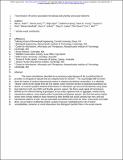Transmission of human-associated microbiota along family and social networks
Author(s)
Brito, Ilana L.; Gurry, Thomas Jerome; Zhao, Shijie; Huang, Katherine; Young, Sarah K.; Shea, Terrence P.; Naisilisili, Waisea; Jenkins, Aaron P.; Jupiter, Stacy D.; Gevers, Dirk; Alm, Eric J; ... Show more Show less
DownloadSubmitted version (1.889Mb)
Publisher Policy
Publisher Policy
Article is made available in accordance with the publisher's policy and may be subject to US copyright law. Please refer to the publisher's site for terms of use.
Terms of use
Metadata
Show full item recordAbstract
The human microbiome, described as an accessory organ because of the crucial functions it provides, is composed of species that are uniquely found in humans1,2. Yet, surprisingly little is known about the impact of routine interpersonal contacts in shaping microbiome composition. In a relatively ‘closed’ cohort of 287 people from the Fiji Islands, where common barriers to bacterial transmission are absent, we examine putative bacterial transmission in individuals’ gut and oral microbiomes using strain-level data from both core single-nucleotide polymorphisms and flexible genomic regions. We find a weak signal of transmission, defined by the inferred sharing of genotypes, across many organisms that, in aggregate, reveals strong transmission patterns, most notably within households and between spouses. We were unable to determine the directionality of transmission nor whether it was direct. We further find that women harbour strains more closely related to those harboured by their familial and social contacts than men, and that transmission patterns of oral-associated and gut-associated microbiota need not be the same. Using strain-level data alone, we are able to confidently predict a subset of spouses, highlighting the role of shared susceptibilities, behaviours or social interactions that distinguish specific links in the social network.
Date issued
2019-03Department
Massachusetts Institute of Technology. Department of Biological Engineering; Massachusetts Institute of Technology. Department of Civil and Environmental EngineeringPublisher
Springer Science and Business Media LLC
Citation
Brito, Ilana L. "Transmission of human-associated microbiota along family and social networks." Nature Microbiology 4, 6 (March 2019): 964–971 © 2019 The Author(s)
Version: Original manuscript
ISSN
2058-5276